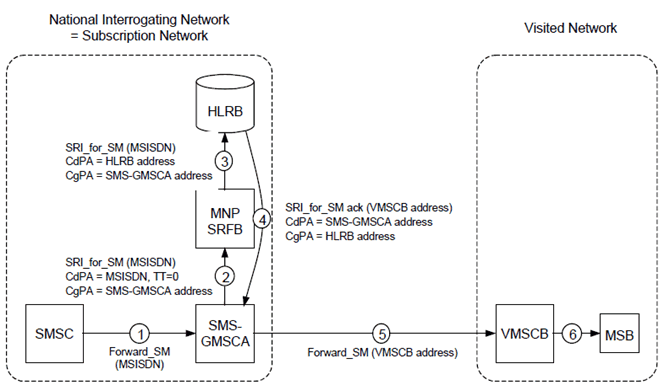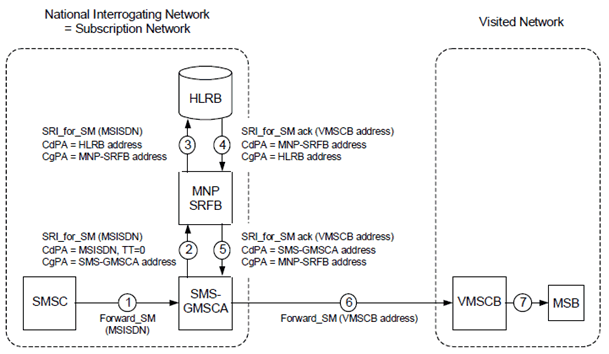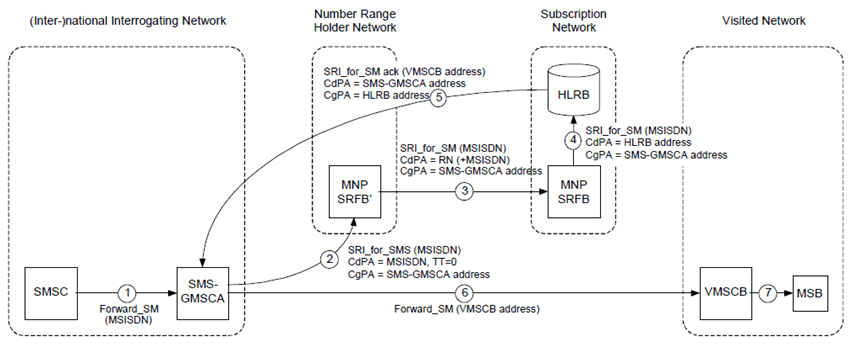Content for TS 23.066 Word version: 18.0.0
B.4 Signalling Scenarios (informative)
B.4.1 Delivery of SMS to a Non-ported Number - Direct Routeing - MNP-SRF acts as SCCP Relay
B.4.2 Delivery of SMS to a Non-ported Number - Direct Routeing - MNP-SRF acts as Higher-level Relay
B.4.3 Delivery of SMS to a Ported Number - Indirect Routeing
...
...
B.4 Signalling Scenarios (informative) p. 49
This (informative) clause contains examples of signalling scenarios.
B.4.1 Delivery of SMS to a Non-ported Number - Direct Routeing - MNP-SRF acts as SCCP Relay p. 49
Figure B.4.1 shows the MNP-SRF operation for delivering an SMS message to a non-ported number.

Figure B.4.1: SRF operation for delivering an SMS message to a non-ported number where the SRI_for_SM message is submitted by a national interrogating network
(⇒ copy of original 3GPP image)
(⇒ copy of original 3GPP image)
- The SMSC forwards a SM to the SMS-GMSC via a proprietary interface.
- The SMS-GMSC generates a routeing enquiry for SM delivery. The MAP SRI_for_SM message is routed to the network's MNP-SRF.
- When MNP-SRFB receives the message, MNP-SRF operation is triggered. The MNP-SRF functionality analyses the MSISDN in the CdPA and identifies the MSISDN as being non-ported using information which may be retrieved from an NP database. The MNP-SRF function then populates the CdPA with an HLRB address. After modifying the CdPA, the message is routed to HLRB.
- HLRB responds to the routeing enquiry by sending back an SRI_for_SM ack with the address of the VMSC.
- The SMS-GMSC can now deliver the message to the VMSCB using a Forward_SMS message.
- VMSCB further delivers the message to MSB.
B.4.2 Delivery of SMS to a Non-ported Number - Direct Routeing - MNP-SRF acts as Higher-level Relay p. 50
Figure B.4.2 shows the MNP-SRF operation for delivering an SMS message to a non-ported number where the SRI_for_SM message is submitted by a national interrogating network. For further details of the higher level relay function (e.g. TC relay), the reader is referred to [7].

Figure B.4.2: SRF operation for delivering an SMS message to a non-ported number where the SRI_for_SM message is submitted by a national interrogating network
(⇒ copy of original 3GPP image)
(⇒ copy of original 3GPP image)
- The SMSC forwards a SM to the SMS-GMSC via a proprietary interface.
- The SMS-GMSC generates a routeing enquiry for SM delivery. The MAP SRI_for_SM message is routed to the network's MNP-SRF.
- When MNP-SRFB receives the message it terminates the TCAP dialogue and an MNP-SRF operation is triggered. The MNP-SRF functionality analyses the MSISDN in the TCAP portion of the message and identifies the MSISDN as being non-ported using information which may be retrieved from an NP database. The MNP-SRF function then initiates a new dialogue and routes the message to HLRB.
- HLRB responds to the routeing enquiry by sending back an SRI_for_SM ack with the address of the VMSC.
- MNP-SRFB responds to the routeing enquiry by sending back an SRI_for_SM ack with the address of the VMSC to the SMS-GMSCA.
- The SMS-GMSC can now deliver the message to the VMSCB using a Forward_SMS message.
- VMSCB further delivers the message to MSB.
B.4.3 Delivery of SMS to a Ported Number - Indirect Routeing p. 51
Figure B.4.3 shows the MNP-SRF operation for delivering an SMS message to a ported number where the interrogating network does not support direct routeing.
The message flows for this scenario are based on the use of an SCCP-relay function in the MNP-SRF(s). If the MNP-SRF(s) use(s) a higher-level relay function (e.g. TC-relay), then the response message will go via the MNP-SRF as shown in clause B.4.2. For further details of the signalling relay functions, the reader is referred to [7].

Figure B.4.3: SRF operation for delivering an SMS message to a ported number where the interrogating network does not support direct routeing
(⇒ copy of original 3GPP image)
(⇒ copy of original 3GPP image)
- The SMSC forwards a SM to the SMS-GMSC via a proprietary interface.
- The SMS-GMSC generates a routeing enquiry for SM delivery. The MAP SRI_for_SM message is routed to the number range holder network's MNP-SRF.
- When MNP-SRFB' receives the message, MNP-SRF operation is triggered. The MNP-SRF functionality analyses the MSISDN in the CdPA and identifies the MSISDN as being ported using information which may be retrieved from an NP database. As the message is non-call related, the MNP-SRF function then populates the CdPA with either a routeing number or a concatenation of a routeing number and MSISDN. After modifying the CdPA, the message is routed to MNP-SRFB in the subscription network.
- When MNP-SRFB receives the message, MNP-SRF operation is triggered. The MNP-SRF functionality analyses the MSISDN in the CdPA and identifies the MSISDN as being ported into the network using information which may be retrieved from an NP database. The MNP-SRF function then populates the CdPA with an HLRB address. After modifying the CdPA, the message is routed to HLRB.
- HLRB responds to the routeing enquiry by sending back an SRI_for_SM ack with the address of the VMSC.
- The SMS-GMSC can now deliver the message to the VMSCB using a Forward_SMS message.
- VMSCB further delivers the message to MSB.